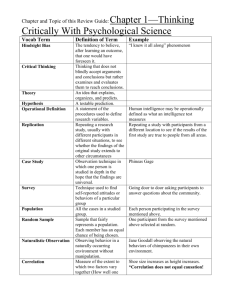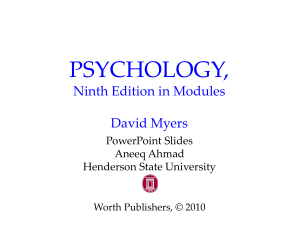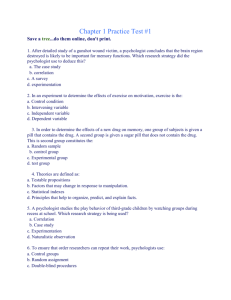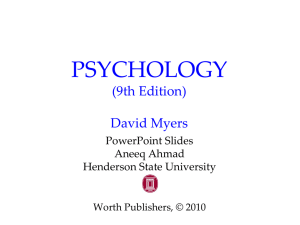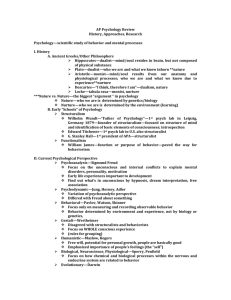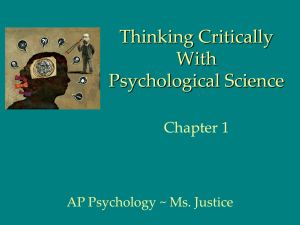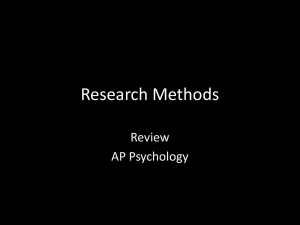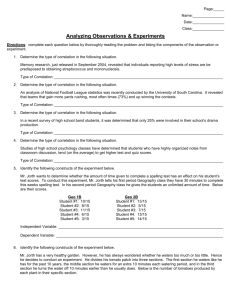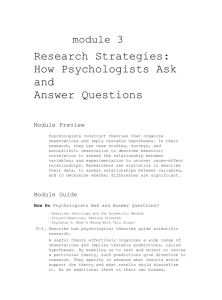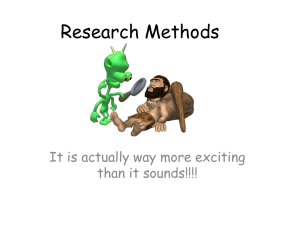Unit II notes
advertisement
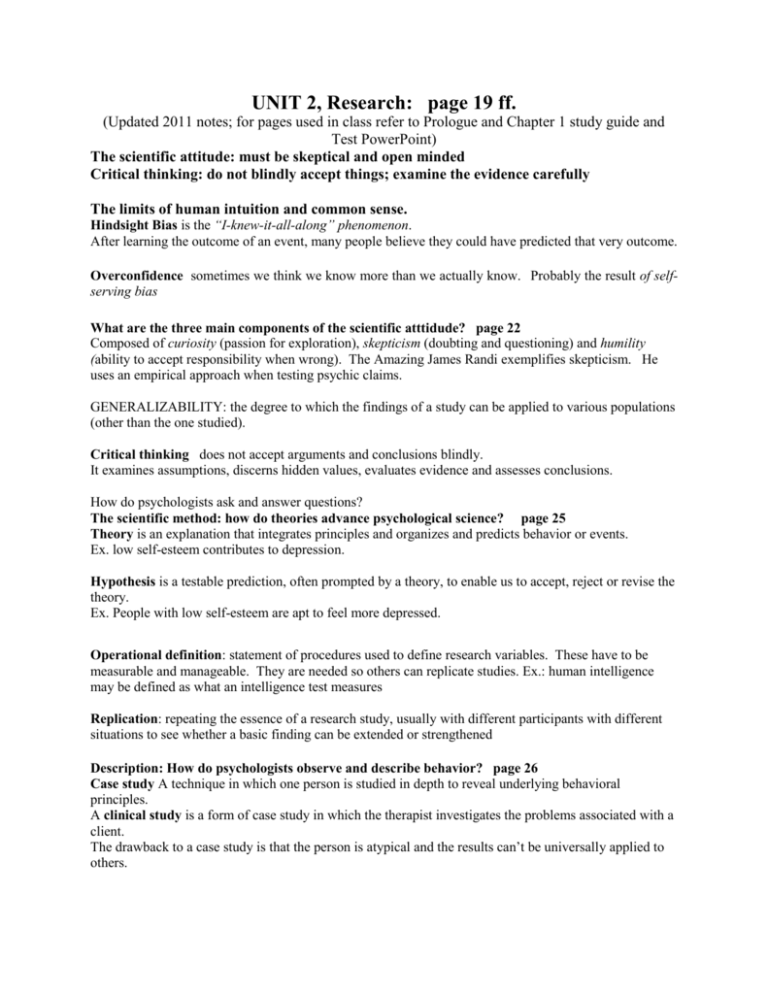
UNIT 2, Research: page 19 ff. (Updated 2011 notes; for pages used in class refer to Prologue and Chapter 1 study guide and Test PowerPoint) The scientific attitude: must be skeptical and open minded Critical thinking: do not blindly accept things; examine the evidence carefully The limits of human intuition and common sense. Hindsight Bias is the “I-knew-it-all-along” phenomenon. After learning the outcome of an event, many people believe they could have predicted that very outcome. Overconfidence sometimes we think we know more than we actually know. Probably the result of selfserving bias What are the three main components of the scientific atttidude? page 22 Composed of curiosity (passion for exploration), skepticism (doubting and questioning) and humility (ability to accept responsibility when wrong). The Amazing James Randi exemplifies skepticism. He uses an empirical approach when testing psychic claims. GENERALIZABILITY: the degree to which the findings of a study can be applied to various populations (other than the one studied). Critical thinking does not accept arguments and conclusions blindly. It examines assumptions, discerns hidden values, evaluates evidence and assesses conclusions. How do psychologists ask and answer questions? The scientific method: how do theories advance psychological science? page 25 Theory is an explanation that integrates principles and organizes and predicts behavior or events. Ex. low self-esteem contributes to depression. Hypothesis is a testable prediction, often prompted by a theory, to enable us to accept, reject or revise the theory. Ex. People with low self-esteem are apt to feel more depressed. Operational definition: statement of procedures used to define research variables. These have to be measurable and manageable. They are needed so others can replicate studies. Ex.: human intelligence may be defined as what an intelligence test measures Replication: repeating the essence of a research study, usually with different participants with different situations to see whether a basic finding can be extended or strengthened Description: How do psychologists observe and describe behavior? page 26 Case study A technique in which one person is studied in depth to reveal underlying behavioral principles. A clinical study is a form of case study in which the therapist investigates the problems associated with a client. The drawback to a case study is that the person is atypical and the results can’t be universally applied to others. Survey A technique for ascertaining the self-reported attitudes, opinions or behaviors of people usually done by questioning a representative, random sample of people. A random sample is usually representative of the population. The population is all cases in a group, and you must draw from a representative sample for a good survey The drawback is that the results rely on self-reporting: how do you know the person is accurate or honest? Wording effects: Wording can change the results of a survey. Q: Should cigarette ads and pornography be allowed on television? (not allowed vs. forbid) False Consensus Effect (see also page 489) A tendency to overestimate the extent to which others share our beliefs and behaviors. Random Sampling v. Random assignment: an important difference for the AP College Board Psychology exam, page 27 If each member of a population has an equal chance of inclusion into a sample, it is called a random sample (unbiased). If the survey sample is biased, its results are not valid. Random assignment occurs in experiments AFTER the random sample has been chosen. Subjects are then randomly assigned to the experimental or control groups. Naturalistic Observation 28 Observing and recording the behavior of animals in the wild and recording self-seating patterns in a multiracial school lunchroom constitute naturalistic observation. Example: chimp research Frans de Waal. All three above do not explain why the behavior occurs What are positive and negative correlations? page 30 When one trait or behavior accompanies another, we say the two correlate. Scatterplot: show patterns to correlation; each point plots the value of two variables The slope of the points depicts the direction, while the amount of scatter depicts the strength of the relationship. A positive (or direct) correlation sees both variables moving in the same direction A negative (or inverse) correlation sees both variables moving in opposite directions The larger the number between 0 and 1 (positive) and 0 and –1 (negative) the more closely the two variables are related Correlation Coefficient is a statistical measure of the relationship between two variables; can tell you how much one score can predict another. Ex: how well do intelligence scores predict achievement? Determining the strength of a correlation coefficient: the closer the number is to 1 or -1, the stronger the correlation; 0 means no relation at all. Correlation and causation 31 Correlation doesn’t equal causation What are illusory correlations? page 32 The perception of a relationship where no relationship actually exists; happens when we see random events as connected. These are powered by confirmation bias: looking for something that confirms our beliefs. When shown we are wrong, we deny it, not wanting to admit error. Ex. Parents conceive children after adoption. See figure 2.5 Order in randomness Given random data, we look for order and meaningful patterns. Given large numbers of random outcomes, a few are likely to express order. Experimentation: how do experiments, powered by random assignment, clarify cause and effect? page 34 A research method in which the researcher manipulates one or more variables in order to observe some mental or behavioral event; participants must be randomly assigned to experimental and control groups with all factors other than the independent variable controlled Experimentation is the backbone of psychology research. Experiments isolate causes and their effects. Experimental condition: that which exposes the subject to treatment Control condition: serves as a comparison; similar subjects who do not receive the treatment Within subject design: comparing subjects to themselves; pre-test/post-test; subjects are their own control Between subject design: one group compared to another; only one group gets the independent variable Many factors influence our behavior. Experiments (1) manipulate factors that interest us, while other factors are kept under (2) control. Effects generated by manipulated factors isolate cause and effect relationships. Page 35 An Independent Variable is a factor manipulated by the experimenter. The effect of the independent variable is the focus of the study. For example, when examining the effects of breast feeding upon intelligence, breast feeding is the independent variable. Confounding variable: other factors which can affect results; random assignment is supposed to address these A Dependent Variable is a measured factor that may change in response to an independent variable. In psychology, it is usually a behavior or a mental process. For example, in our study on the effect of breast-feeding upon intelligence, intelligence is the dependent variable. Double blind procedure: In evaluating drug therapies, patients and experimenter’s assistants should remain unaware of which patients had the real treatment and which patients had the placebo treatment. Assigning participants to experimental (Breast-fed) and control (formula-fed) conditions by random assignment minimizes pre-existing differences between the two groups. Placebo effect: experimental results caused by expectations alone or by an inert substance that the patient/subject assumes is an active agent See table 2.3 page 36 in text. Statistical reasoning in everyday life page 37 Statistical procedures analyze and interpret data allowing us to see what the unaided eye misses. Describing data: how can we describe date with measures of central tendency and variation? A meaningful description of data is important in research. Misrepresentation may lead to incorrect conclusions. Measures of central tendency Mode: The most frequently occurring score in a distribution. Mean: The arithmetic average of scores in a distribution obtained by adding the scores and then dividing by the number of scores that were added together. Median: The middle score in a rank-ordered distribution. A skewed Distribution: figure 2.9 shows a positive skew: the tail of the whale goes in the positive direction. “The tail of the whale drags the mean.” In a negative skew the mean is pulled in the direction of lower scores. Skew=Lopsided data Measures in variation Range: The difference between the highest and lowest scores in a distribution. Standard Deviation: A computed measure of how much scores vary around the mean. The lower the deviation the more consistent the scores (most around the mean), the higher the SD the more inconsistent the data. The variance tells you how far a set of numbers is spread out. KNOW the percentages for the one, two and three standard deviations from the mean. The normal curve on page 40 has them: one=34%, two= 13.5% and three=2%. Knowing the standard deviation can tell you how far any one score is from the average. So, for example, Bob Petrella, a supermemorist who can remember every detail from all of his birthdays back to childhood, has a hippocampus (helps form memories) that is seven standard deviations beyond the mean. This means his hippocampus is very large compared to most humans, aiding in his memory construction and recall. Making inferences: what principles can guide our making generalizations from samples and deciding whether differences are significant? page 40 Statistical significance: A statistical statement of how frequently an obtained result occurred by experimental manipulation or by chance. We calculate this in the Skittles lab for Unit 4, Sensation and Perception. When is an Observed Difference Reliable? In other words when can you generalize from a sample used in an experiment? 1. Representative samples are better than biased samples. Moral development researcher Lawrence Kohlberg was criticized because he based his theories only on white boys from Chicago. 2. Less variable observations are more reliable than more variable ones. 3. More cases are better than fewer cases. Statistical significance for experimental research page 43 When sample averages are reliable and the difference between them is relatively large, we say the difference has statistical significance. For psychologists this difference is measured through alpha level set at 5 percent. We perform a lab on this measure in Unit 4, Sensation and Perception. FAQ page 42 Q1. Can laboratory experiments illuminate everyday life? Ans: Artificial laboratory conditions are created to study behavior in simplistic terms. The goal is to find underlying principles that govern behavior. Remember that a study only has explanatory power when the findings can be generalized to more than just the group under study. Q2. Does behavior depend on one’s culture? Ans: Even when specific attitudes and behaviors vary across cultures, as they often do, the underlying processes are much the same. Culture is the shared ideas and behaviors passed on from one generation to the next. Q3. Does behavior vary with gender? Ans: Yes. Biology determines our sex, and culture further bends the genders. However, in many ways woman and man are similarly human. Q4. Why do psychologists study animals? Pp. 44-45 Ans: Studying animals gives us the understanding of many behaviors that may have common biology across animals and humans. Q5. Is it ethical to experiment on animals? Ans: Yes; to gain insights to devastating and fatal diseases. All researchers who deal with animal research are required to follow ethical APA guidelines in caring for these animals. Q6. Is it ethical to experiment on people? Ans: Yes. Experiments that do not involve any kind of physical or psychological harm beyond normal levels encountered in daily life may be carried out. APA ethical principles for experimenting on humans page 45 1. obtain informed consent 2. 3. 4. protect from harm and discomfort treating information about subjects confidentially full disclosure of results to subjects afterwards Q7. Is psychology free of value judgments? The research methods are value free but the conclusions are not. Know the key terms on page 48 (see study guide) Try the AP practice questions on pp. 48-49
